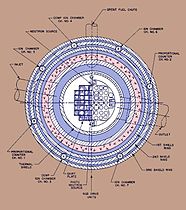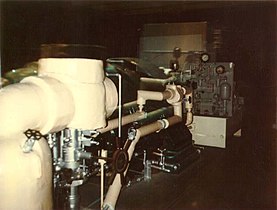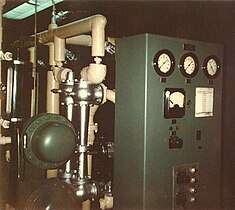
The United States Atomic Energy Commission (AEC) was an agency of the United States government established after World War II by the U.S. Congress to foster and control the peacetime development of atomic science and technology. President Harry S. Truman signed the McMahon/Atomic Energy Act on August 1, 1946, transferring the control of atomic energy from military to civilian hands, effective on January 1, 1947. This shift gave the members of the AEC complete control of the plants, laboratories, equipment, and personnel assembled during the war to produce the atomic bomb.

Fort Greely is a census-designated place (CDP) in Southeast Fairbanks Census Area, Alaska, United States. It is home to the Fort Greely military installation. At the 2010 census the population was 539, up from 461 in 2000.

A nuclear and radiation accident is defined by the International Atomic Energy Agency (IAEA) as "an event that has led to significant consequences to people, the environment or the facility. Examples include lethal effects to individuals, large radioactivity release to the environment, reactor core melt." The prime example of a "major nuclear accident" is one in which a reactor core is damaged and significant amounts of radioactive isotopes are released, such as in the Chernobyl disaster in 1986 and Fukushima nuclear disaster in 2011.
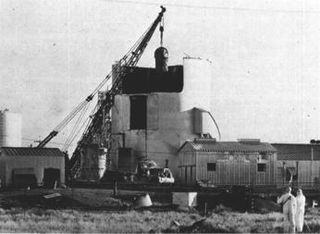
Stationary Low-Power Reactor Number One, also known as SL-1 or the Argonne Low Power Reactor (ALPR), was a United States Army experimental nuclear reactor in the western United States at the National Reactor Testing Station (NRTS) in Idaho about forty miles (65 km) west of Idaho Falls, now the Idaho National Laboratory. On January 3, 1961, a steam explosion killed all three of its young military operators, pinning one of them to the ceiling with a reactor vessel plug. It remains the only U.S. reactor accident to cause immediate deaths.
The Army Nuclear Power Program (ANPP) was a program of the United States Army to develop small pressurized water and boiling water nuclear power reactors to generate electrical and space-heating energy primarily at remote, relatively inaccessible sites. The ANPP had several accomplishments, but ultimately it was considered to be "a solution in search of a problem." The U.S. Army Engineer Reactors Group managed this program and it was headquartered at Fort Belvoir, Virginia. The program began in 1954 and had effectively terminated by about 1977, with the last class of NPP operators graduating in 1977. Work continued for some time thereafter either for decommissioning of the plants or placing them into SAFSTOR. The current development of small modular reactors has led to a renewed interest in military applications.

ML-1 was an experimental nuclear reactor built as part of the US Army Nuclear Power Program between 1961 and 1965. It was intended to provide truck-mounted nuclear power that could accompany troops from place to place and provide power to command and communication centers, evacuation hospitals, depots, and radar and weapons systems.

The Shippingport Atomic Power Station was the world's first full-scale atomic electric power plant devoted exclusively to peacetime uses. It was located near the present-day Beaver Valley Nuclear Generating Station on the Ohio River in Beaver County, Pennsylvania, United States, about 25 miles (40 km) from Pittsburgh.

Naval Reactors (NR), which administers the Naval Nuclear Propulsion Program, is an umbrella term for the U.S. government office that has comprehensive responsibility for the safe and reliable operation of the United States Navy's nuclear reactors "from womb to tomb." A single entity, it has authority and reporting responsibilities within both the Naval Sea Systems Command and the National Nuclear Security Administration (NA-30). Moreover, the Director of Naval Reactors also serves as a special assistant to the Chief of Naval Operations for Naval Nuclear Propulsion.

The Aircraft Nuclear Propulsion (ANP) program and the preceding Nuclear Energy for the Propulsion of Aircraft (NEPA) project worked to develop a nuclear propulsion system for aircraft. The United States Army Air Forces initiated Project NEPA on May 28, 1946. NEPA operated until May 1951, when the project was transferred to the joint Atomic Energy Commission (AEC)/USAF ANP. The USAF pursued two different systems for nuclear-powered jet engines, the Direct Air Cycle concept, which was developed by General Electric, and Indirect Air Cycle, which was assigned to Pratt & Whitney. The program was intended to develop and test the Convair X-6, but was canceled in 1961 before that aircraft was built. The total cost of the program from 1946 to 1961 was about $1 billion.

Fermi 1 was the United States' only demonstration-scale breeder reactor, built during the 1950s at the Enrico Fermi Nuclear Generating Station on the western shore of Lake Erie south of Detroit, Michigan. It used the sodium-cooled fast reactor cycle, in which liquid sodium metal is used as the primary coolant instead of more typical nuclear reactor designs which are cooled with water. Sodium cooling allows for a more compact core with surplus neutrons, which are used to produce more fission fuel by converting a surrounding "blanket" of 238U into 239Pu which can be fed back into a reactor. At full power, it would generate 430 MW of heat (MWt), or about 150 MW of electricity (MWe).

North Carolina State University in 1950 founded the first university-based reactor program and Nuclear Engineering curriculum in the United States. The program continues in the early 21st century. That year, NC State College administrators approved construction of a reactor and the establishment of a collegiate nuclear engineering program. The first research reactor was completed in 1953; it was scaled up in 1957 and 1960. It was deactivated in 1973 to make way for the PULSTAR reactor. The old reactor has been decommissioned.
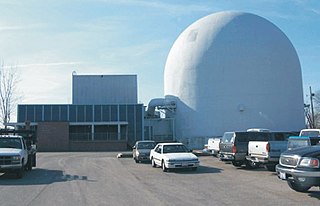
The Piqua Nuclear Power Facility was an organic cooled and moderated nuclear reactor which operated just outside the southern city limits of Piqua, Ohio in the United States. The plant contained a 45.5-megawatt (thermal) organically cooled and moderated nuclear reactor. The Piqua facility was built and operated between 1963 and 1966 as a demonstration project by the Atomic Energy Commission. The facility ceased operation in 1966. It was dismantled between 1967 and 1969, and the radioactive coolant and most other radioactive materials were removed. The remaining radioactive structural components of the reactor were entombed in the reactor vessel under sand and concrete.

The Hallam Nuclear Power Facility (HNPF) in Nebraska was a 75 MWe sodium-cooled graphite-moderated nuclear power plant built by Atomics International and operated by Consumers Public Power District of Nebraska. It was built in tandem with and co-located with a conventional coal-fired power station, the Sheldon Power Station. The facility featured a shared turbo generator that could accept steam from either heat source, and a shared control room.

Tarapur Atomic Power Station (T.A.P.S.) is located in Tarapur, Palghar, India. It was the first commercial nuclear power station built in India.

MH-1A was the first floating nuclear power station. Named Sturgis after General Samuel D. Sturgis, Jr., this pressurized water reactor built in a converted Liberty ship was part of a series of reactors in the US Army Nuclear Power Program, which aimed to develop small nuclear reactors to generate electrical and space-heating energy primarily at remote, relatively inaccessible sites. Its designation stood for mobile, high power. After its first criticality in 1967, MH-1A was towed to the Panama Canal Zone that it supplied with 10 MW of electricity. Its dismantling began in 2014 and was completed in March 2019.

Major General Kenneth David Nichols CBE was an officer in the United States Army, and a civil engineer who worked on the secret Manhattan Project, which developed the atomic bomb during World War II. He served as Deputy District Engineer to James C. Marshall, and from 13 August 1943 as the District Engineer of the Manhattan Engineer District. Nichols led both the uranium production facility at the Clinton Engineer Works at Oak Ridge, Tennessee, and the plutonium production facility at Hanford Engineer Works in Washington state.

Atomics International was a division of the North American Aviation company which engaged principally in the early development of nuclear technology and nuclear reactors for both commercial and government applications. Atomics International was responsible for a number of accomplishments relating to nuclear energy: design, construction and operation of the first nuclear reactor in California (1952), the first nuclear reactor to produce power for a commercial power grid in the United States (1957) and the first nuclear reactor launched into outer space by the United States (1965).
Arnold "Arnie" Gundersen is a former nuclear industry executive, and engineer with more than 44 years of nuclear industry experience who became a whistleblower in 1990. Gundersen has written dozens of expert reports for nongovernment organizations and the state of Vermont. Gunderson was a licensed reactor operator from 1971-1972 on Rensselaer Polytechnic Institute's zero-power open-pool university research reactor at the Reactor Critical Facility in Schenectady, New York, where he was a nuclear engineering graduate student.

The Materials Testing Reactor (MTR) was an early nuclear reactor specifically designed to facilitate the conception and design of future reactors. It produced much of the foundational irradiation data that underlies the nuclear power industry. It operated in Idaho at the National Reactor Testing Station from 1952 to 1970.
This is a history of nuclear power as realized through the first artificial fission of atoms that would lead to the Manhattan Project and, eventually, to using nuclear fission to generate electricity.



